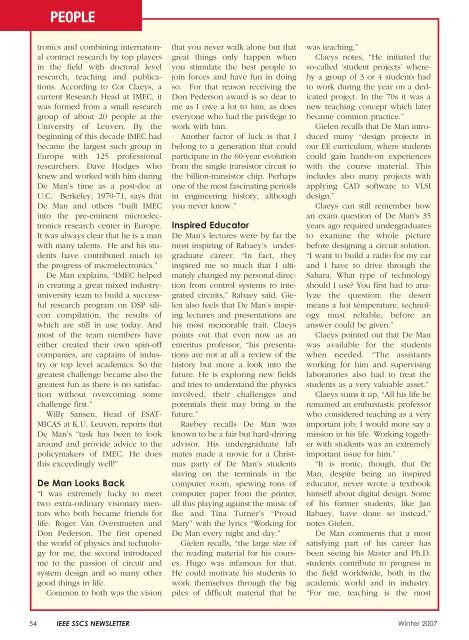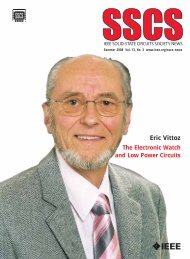The Impact of Dennard's Scaling Theory - IEEE
The Impact of Dennard's Scaling Theory - IEEE
The Impact of Dennard's Scaling Theory - IEEE
- TAGS
- scaling
- www.ieee.org
You also want an ePaper? Increase the reach of your titles
YUMPU automatically turns print PDFs into web optimized ePapers that Google loves.
PEOPLE<br />
tronics and combining international<br />
contract research by top players<br />
in the field with doctoral level<br />
research, teaching and publications.<br />
According to Cor Claeys, a<br />
current Research Head at IMEC, it<br />
was formed from a small research<br />
group <strong>of</strong> about 20 people at the<br />
University <strong>of</strong> Leuven. By the<br />
beginning <strong>of</strong> this decade IMEC had<br />
became the largest such group in<br />
Europe with 125 pr<strong>of</strong>essional<br />
researchers. Dave Hodges who<br />
knew and worked with him during<br />
De Man’s time as a post-doc at<br />
U.C. Berkeley, 1970-71, says that<br />
De Man and others “built IMEC<br />
into the pre-eminent microelectronics<br />
research center in Europe.<br />
It was always clear that he is a man<br />
with many talents. He and his students<br />
have contributed much to<br />
the progress <strong>of</strong> microelectronics.”<br />
De Man explains, “IMEC helped<br />
in creating a great mixed industryuniversity<br />
team to build a successful<br />
research program on DSP silicon<br />
compilation, the results <strong>of</strong><br />
which are still in use today. And<br />
most <strong>of</strong> the team members have<br />
either created their own spin-<strong>of</strong>f<br />
companies, are captains <strong>of</strong> industry<br />
or top level academics. So the<br />
greatest challenge became also the<br />
greatest fun as there is no satisfaction<br />
without overcoming some<br />
challenge first.”<br />
Willy Sansen, Head <strong>of</strong> ESAT-<br />
MICAS at K.U. Leuven, reports that<br />
De Man’s “task has been to look<br />
around and provide advice to the<br />
policymakers <strong>of</strong> IMEC. He does<br />
this exceedingly well!”<br />
De Man Looks Back<br />
“I was extremely lucky to meet<br />
two extra-ordinary visionary mentors<br />
who both became friends for<br />
life: Roger Van Overstraeten and<br />
Don Pederson. <strong>The</strong> first opened<br />
the world <strong>of</strong> physics and technology<br />
for me, the second introduced<br />
me to the passion <strong>of</strong> circuit and<br />
system design and so many other<br />
good things in life.<br />
Common to both was the vision<br />
that you never walk alone but that<br />
great things only happen when<br />
you stimulate the best people to<br />
join forces and have fun in doing<br />
so. For that reason receiving the<br />
Don Pederson award is so dear to<br />
me as I owe a lot to him, as does<br />
everyone who had the privilege to<br />
work with him.<br />
Another factor <strong>of</strong> luck is that I<br />
belong to a generation that could<br />
participate in the 60-year evolution<br />
from the single transistor circuit to<br />
the billion-transistor chip. Perhaps<br />
one <strong>of</strong> the most fascinating periods<br />
in engineering history, although<br />
you never know.”<br />
Inspired Educator<br />
De Man’s lectures were by far the<br />
most inspiring <strong>of</strong> Rabaey’s undergraduate<br />
career. “In fact, they<br />
inspired me so much that I ultimately<br />
changed my personal direction<br />
from control systems to integrated<br />
circuits,” Rabaey said. Gielen<br />
also feels that De Man’s inspiring<br />
lectures and presentations are<br />
his most memorable trait. Claeys<br />
points out that even now as an<br />
emeritus pr<strong>of</strong>essor, “his presentations<br />
are not at all a review <strong>of</strong> the<br />
history but more a look into the<br />
future. He is exploring new fields<br />
and tries to understand the physics<br />
involved, their challenges and<br />
potentials their may bring in the<br />
future.”<br />
Raebey recalls De Man was<br />
known to be a fair but hard-driving<br />
advisor. His undergraduate lab<br />
mates made a movie for a Christmas<br />
party <strong>of</strong> De Man’s students<br />
slaving on the terminals in the<br />
computer room, spewing tons <strong>of</strong><br />
computer paper from the printer,<br />
all this playing against the music <strong>of</strong><br />
Ike and Tina Turner’s “Proud<br />
Mary” with the lyrics “Working for<br />
De Man every night and day.”<br />
Gielen recalls, “the large size <strong>of</strong><br />
the reading material for his courses.<br />
Hugo was infamous for that.<br />
He could motivate his students to<br />
work themselves through the big<br />
piles <strong>of</strong> difficult material that he<br />
was teaching.”<br />
Claeys notes, “He initiated the<br />
so-called ‘student projects’ whereby<br />
a group <strong>of</strong> 3 or 4 students had<br />
to work during the year on a dedicated<br />
project. In the 70s it was a<br />
new teaching concept which later<br />
became common practice.”<br />
Gielen recalls that De Man introduced<br />
many “design projects in<br />
our EE curriculum, where students<br />
could gain hands-on experiences<br />
with the course material. This<br />
includes also many projects with<br />
applying CAD s<strong>of</strong>tware to VLSI<br />
design.”<br />
Claeys can still remember how<br />
an exam question <strong>of</strong> De Man’s 35<br />
years ago required undergraduates<br />
to examine the whole picture<br />
before designing a circuit solution.<br />
“I want to build a radio for my car<br />
and I have to drive through the<br />
Sahara, What type <strong>of</strong> technology<br />
should I use? You first had to analyze<br />
the question: the desert<br />
means a hot temperature, technology<br />
must reliable, before an<br />
answer could be given.”<br />
Claeys pointed out that De Man<br />
was available for the students<br />
when needed. “<strong>The</strong> assistants<br />
working for him and supervising<br />
laboratories also had to treat the<br />
students as a very valuable asset.”<br />
Claeys sums it up, “All his life he<br />
remained an enthusiastic pr<strong>of</strong>essor<br />
who considered teaching as a very<br />
important job; I would more say a<br />
mission in his life. Working together<br />
with students was an extremely<br />
important issue for him.”<br />
“It is ironic, though, that De<br />
Man, despite being an inspired<br />
educator, never wrote a textbook<br />
himself about digital design. Some<br />
<strong>of</strong> his former students, like Jan<br />
Rabaey, have done so instead,”<br />
notes Gielen.<br />
De Man comments that a most<br />
satisfying part <strong>of</strong> his career has<br />
been seeing his Master and Ph.D.<br />
students contribute to progress in<br />
the field worldwide, both in the<br />
academic world and in industry.<br />
“For me, teaching is the most<br />
54 <strong>IEEE</strong> SSCS NEWSLETTER Winter 2007




